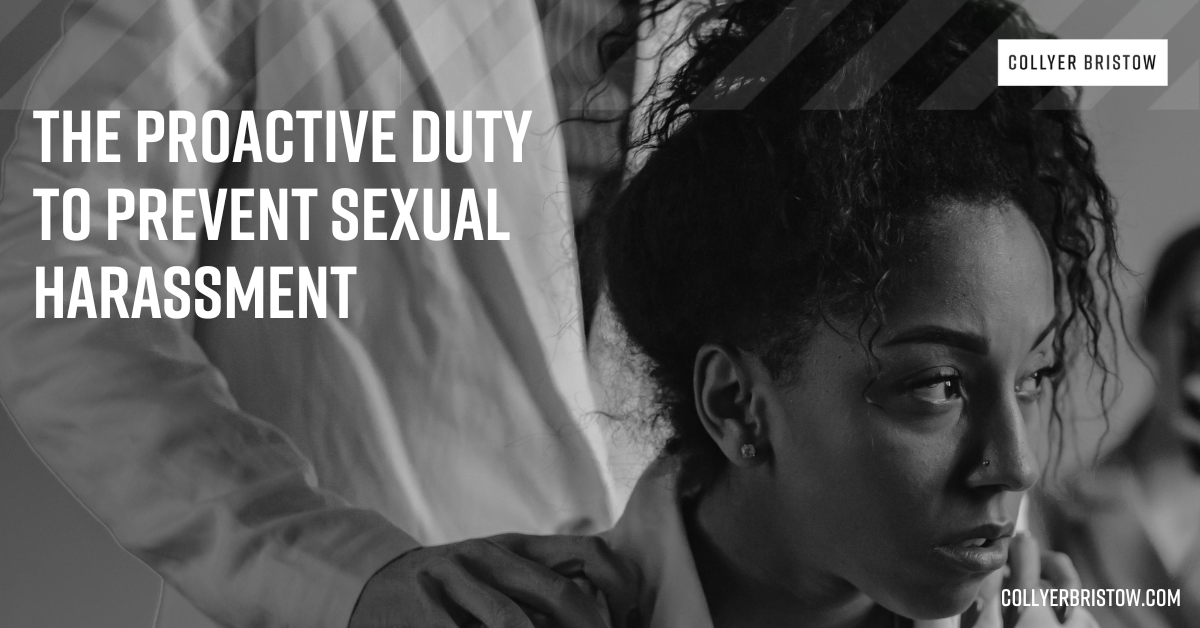- Employment law for employees
- Employment law for employers

Longer Reads
Workplace culture and the proactive duty to prevent sexual harassment: What do employers need to know?
From 26 October 2024, employers will have a new legal obligation to “take reasonable steps” to prevent sexual harassment. Here we explain how the law is changing, sanctions for non-compliance and what you can be doing now to prepare for the new duty in the run-up to October and beyond.
7 minute read
Published 23 August 2024
Key information
- Specialisms
- Business
From 26 October 2024, employers will have a new legal obligation to “take reasonable steps” to prevent sexual harassment. Here we explain how the law is changing, sanctions for non-compliance and what you can be doing now to prepare for the new duty in the run-up to October and beyond.
How is the law changing?
The Equality Act 2010 prohibits sexual harassment. Sexual harassment occurs where both: a person engages in unwanted conduct of a sexual nature and the conduct has the purpose and effect of either violating that person’s dignity or creating an intimidating, hostile, degrading, humiliating or offensive environment for that person. Examples include sexual comments or jokes, displaying sexually graphic photos, spreading sexual rumours about a person and asking intrusive questions about a person’s private or sex life. Employers are prima facie vicariously liable (even if they didn’t know or approve the conduct) unless they can demonstrate they took “all reasonable steps” to prevent it. The defence is rarely successful in practice as “all reasonable steps” is a high threshold.
Whilst the “all reasonable steps” defence will remain, a new positive obligation will come into force that will require employers to put reasonable steps in place to proactively prevent sexual harassment of employees from arising in the first place in the course of their employment. Employers that face an allegation of sexual harassment will need to demonstrate the targeted measures they have implemented to comply with this positive duty to protect employees from sexual harassment. Unlike the “all reasonable steps” defence, the new duty is limited to preventing sexual harassment only so does not apply to other types of discrimination or harassment.
Failure to comply with the new duty may open employers up to both financial and reputational risks. Firstly, if an employee succeeds in bringing a claim in the Employment Tribunal for sexual harassment and the employer is found to have breached its duty to take reasonable steps to prevent the sexual harassment there will be a corresponding new compensation uplift of up to 25%. As there is no cap on the compensation that can be awarded for unlawful harassment, this uplift could result in a substantial increase. The Tribunal already has the power to apply a percentage uplift to an award where an employer has unreasonably failed to follow the Acas Code on Disciplinary and Grievance Procedures. However, the maximum percentage uplift (also 25%) is only awarded in exceptional cases. It remains to be seen whether the Tribunal will take a different approach to the uplift on sexual harassment claims.
Separately, and more significantly, from a reputational perspective the Equality and Human Rights Commission (EHRC) will also have the power to enforce the duty and will therefore be able to take enforcement action against organisations who are in breach of the new duty. In addition, tribunal proceedings are open to the public meaning the names of employers and/or individuals involved may be reported on in the media which can have potentially wide-ranging and detrimental ramifications on the reputation of the business.
What are reasonable steps and what can employers do to demonstrate compliance?
Back in January 2020, the EHRC published technical guidance to assist employers in understanding how the Equality Act 2020 prohibits harassment at work, which includes examples and case studies, and is helpful in enabling employers to understand their legal obligations. The EHRC has published a draft of its updated guidance on sexual harassment to reflect the new duty which was under consultation until 6 August 2024. The guidance is expected to be finalised in September 2024. This being said, given the draft guidance is available, employers should start taking steps to ensure compliance with the new duty (and any regulatory obligations they have) now. In line with this, the updated draft guidance adds a whole new section on the duty to prevent sexual harassment of workers called the “preventative duty”. As it is a preventative duty, it confirms that employers will need to anticipate scenarios when workers may be subject to sexual harassment in the course of employment and take action to prevent it. Correspondingly, if sexual harassment has taken place, the employer should take action to stop it happening again. It is therefore increasingly important that employers assess the risk in their business and take steps to mitigate this risk where possible.
The draft guidance also makes it clear that the preventative duty is intended to apply to harassment by third parties, such as customers and clients, service users and members of the public. The draft guidance is clear that employers should consider the risk of employees encountering third parties, the risk of sexual harassment occurring in those situations and should take reasonable steps to prevent harassment in those instances. Harassment by third parties is not currently covered by the law (although the Labour government proposes that it should be), so many employers may currently pay less attention to this than to harassment by colleagues. It seems unlikely that a failure to comply with this duty in relation to third parties would lead to an uplift in compensation in most cases because this only applies where the employer is legally liable for sexual harassment. However, the EHRC’s enforcement powers will still apply however, which means a failure of this duty in relation to third parties could still result in difficult EHRC investigations and reputational damage.
When the new duty comes into force in October 2024, all employers will need to be able to show that they have reasonable steps in place to tackle sexual harassment. Having a clear programme in place that is adhered to, and against which the organisation is measured, will make this much easier to demonstrate. Although it is likely you will have measures and processes in place to deal with sexual harassment (and harassment more generally), it is recommended that you audit and review those measures to check that they will be fit for purpose once the new duty takes effect. It is therefore prudent that you address what you need to do now to comply as some steps are not quick fixes and may take some time to filter through.
We look at some of the things that you should be focusing on in more detail below:
1) Assessing risk
One of the main priorities outlined in the EHRC guidance is the assessment of the risks of sexual harassment occurring in an employer’s own business and understanding what steps can be taken to reduce those risks and prevent sexual harassment of their workers. There are numerous ways that employers can identify risks, including employee surveys, keeping records of formal and informal complaints, exit interviews, reviewing absences, culture audits and focus groups. It may also be useful to look at how you “risk assess” other areas of your business, such as health and safety, and reflect this in your risk assessment in this area. Once you have identified the risks and steps that could be taken, you should consider which of those steps it would be reasonable to take and implement them. Although the risks will be specific to each particular business, there are certain factors that could increase the risk of sexual harassment like the presence of alcohol at events, lone working, work travel and customer-facing duties. The draft EHRC guidance indicates that this is equally important for risks caused by all kinds of third parties (including customers, clients, service users, patients, friends and family of colleagues, delegates at a conference and members of the public).
2) Training
The Tribunal has, over the years, made it clear that training which is “stale” because it’s old or no longer relevant, or which is simply a tick-box exercise, will not do the job. Training should be designed for different audiences within the business. For example, those responsible for implementing policies and dealing with complaints (including senior leadership, managers, newly promoted managers and HR) should receive specific training so they understand what to do when they receive a report or allegation, how the investigation will be carried out and how they can support staff. It’s also important they receive training about how to role model appropriate behaviours. In line with any training for managers, all workers should understand what behaviours can constitute sexual harassment and what their role can be in calling out inappropriate behaviour. Allyship or active bystander training can be hugely beneficial in creating a culture where people feel able to speak up or flag concerns at an early stage. Training should be regularly refreshed (especially in organisations with high attrition rates) and records kept of what training has been given and who has attended.
3) Reporting and complaints handling
Employers should be able to illustrate that they have a zero-tolerance approach to sexual harassment where staff understand how to raise complaints and that they trust that their complaint will be listened to and handled with empathy. There should be clear channels to raise concerns about sexual harassment (and harassment in general) and it should be made clear that staff can report behaviour that is against or involves them but also behaviour they have witnessed. It’s also key that they understand how their complaint will be dealt with and by whom. The outcome of any investigation should be assessed as individual complaints can identify wider cultural problems or risks within certain areas of the business (and identifying and addressing those risks is key to being able to show that preventative steps have been taken). Separately, it’s also important to ensure that staff can raise issues outside of formal reporting processes –manager catch-ups, return to work meetings and exit interviews – as it’s not always appropriate or the most effective to resolve issues through formal channels.
It’s time to act now
There are numerous considerations for employers to think about in addition to the areas outlined above but it goes without saying that, aside from the requirement to comply with the new legal duty, taking action to prevent sexual harassment will have many wider benefits for workplace culture, which, in turn, should lead to a safer and more harmonious working environment where there are fewer complaints, absences and departures. An employer’s approach to diversity and inclusion is also increasingly important in helping them attract and retain the best talent and crucially enabling that talent to thrive.
Key focus areas and action points
We have pinpointed five key focus areas and starting points for you to consider when starting the process of ensuring your business is ready for the new legal duty that is due to come into force on 26 October 2024. What is reasonable will vary and will depend on factors such as your size, the sector you operate in, the working environment and your resources. It seems clear therefore that more will be expected of larger employers.
Risk
- What is your risk?
- What are the risks of sexual harassment occurring, and where and when may it be more likely to occur?
- Do you have any learning from issues that have arisen in relation to, for instance, relationship at work, alcohol consumption, work trip and/or social event policies?
Policies and contracts
- What policies do you currently have in place that are relevant to sexual harassment? This may include anti-harassment and bullying, events, alcohol and drugs, social media, whistleblowing, work travel (domestic and international), data protection and non-disclosure clauses and agreements.
- Do you need to update your policies? For example, do they cover social media and out of work scenarios and/or should you have a standalone sexual harassment policy?
- Do you need to improve the way you communicate your policies to drive a zero-tolerance culture regarding harassment?
Training
- What training do you currently do for your workers and how do you communicate these?
- Do you need to update your training or awareness or consider a campaign on this area?
- Has everyone in the organisation recently received specific training on sexual harassment?
- Is your training sufficiently targeted at the right levels of staff and tailored by role?
Reporting
- What policies and programmes do you have in place regarding reporting? This will include formal reporting channels and telephone hotlines run by third parties.
- What claims, issues and grievances have you had in the last three years?
- How are complaints recorded, investigated and resolved? Do they follow your policies? Do they adequately observe confidentiality and support individuals involved?
- Are your reporting mechanisms (both internal and external) sufficient?
Culture
- Is there ownership at board level and does your senior leadership act as role models by issuing statements of policy/intent?
- Have you considered appointing a senior manager as a workplace champion to assess feedback on whether policies and training are working?
- Have you considered appointing other (more junior) staff within the organisation as points of support for those who lodge sexual harassment complaints?
- What can you do to review your culture – i.e., can you update exit interview, engagement surveys and think about a culture audit?
If you would like to discuss any points raised in this article and the steps your business should be taking in relation to the new duty to prevent sexual harassment, then please contact our Employment Team.
Related content
Longer Reads
Workplace culture and the proactive duty to prevent sexual harassment: What do employers need to know?
From 26 October 2024, employers will have a new legal obligation to “take reasonable steps” to prevent sexual harassment. Here we explain how the law is changing, sanctions for non-compliance and what you can be doing now to prepare for the new duty in the run-up to October and beyond.
Published 23 August 2024
Associated sectors / services
From 26 October 2024, employers will have a new legal obligation to “take reasonable steps” to prevent sexual harassment. Here we explain how the law is changing, sanctions for non-compliance and what you can be doing now to prepare for the new duty in the run-up to October and beyond.
How is the law changing?
The Equality Act 2010 prohibits sexual harassment. Sexual harassment occurs where both: a person engages in unwanted conduct of a sexual nature and the conduct has the purpose and effect of either violating that person’s dignity or creating an intimidating, hostile, degrading, humiliating or offensive environment for that person. Examples include sexual comments or jokes, displaying sexually graphic photos, spreading sexual rumours about a person and asking intrusive questions about a person’s private or sex life. Employers are prima facie vicariously liable (even if they didn’t know or approve the conduct) unless they can demonstrate they took “all reasonable steps” to prevent it. The defence is rarely successful in practice as “all reasonable steps” is a high threshold.
Whilst the “all reasonable steps” defence will remain, a new positive obligation will come into force that will require employers to put reasonable steps in place to proactively prevent sexual harassment of employees from arising in the first place in the course of their employment. Employers that face an allegation of sexual harassment will need to demonstrate the targeted measures they have implemented to comply with this positive duty to protect employees from sexual harassment. Unlike the “all reasonable steps” defence, the new duty is limited to preventing sexual harassment only so does not apply to other types of discrimination or harassment.
Failure to comply with the new duty may open employers up to both financial and reputational risks. Firstly, if an employee succeeds in bringing a claim in the Employment Tribunal for sexual harassment and the employer is found to have breached its duty to take reasonable steps to prevent the sexual harassment there will be a corresponding new compensation uplift of up to 25%. As there is no cap on the compensation that can be awarded for unlawful harassment, this uplift could result in a substantial increase. The Tribunal already has the power to apply a percentage uplift to an award where an employer has unreasonably failed to follow the Acas Code on Disciplinary and Grievance Procedures. However, the maximum percentage uplift (also 25%) is only awarded in exceptional cases. It remains to be seen whether the Tribunal will take a different approach to the uplift on sexual harassment claims.
Separately, and more significantly, from a reputational perspective the Equality and Human Rights Commission (EHRC) will also have the power to enforce the duty and will therefore be able to take enforcement action against organisations who are in breach of the new duty. In addition, tribunal proceedings are open to the public meaning the names of employers and/or individuals involved may be reported on in the media which can have potentially wide-ranging and detrimental ramifications on the reputation of the business.
What are reasonable steps and what can employers do to demonstrate compliance?
Back in January 2020, the EHRC published technical guidance to assist employers in understanding how the Equality Act 2020 prohibits harassment at work, which includes examples and case studies, and is helpful in enabling employers to understand their legal obligations. The EHRC has published a draft of its updated guidance on sexual harassment to reflect the new duty which was under consultation until 6 August 2024. The guidance is expected to be finalised in September 2024. This being said, given the draft guidance is available, employers should start taking steps to ensure compliance with the new duty (and any regulatory obligations they have) now. In line with this, the updated draft guidance adds a whole new section on the duty to prevent sexual harassment of workers called the “preventative duty”. As it is a preventative duty, it confirms that employers will need to anticipate scenarios when workers may be subject to sexual harassment in the course of employment and take action to prevent it. Correspondingly, if sexual harassment has taken place, the employer should take action to stop it happening again. It is therefore increasingly important that employers assess the risk in their business and take steps to mitigate this risk where possible.
The draft guidance also makes it clear that the preventative duty is intended to apply to harassment by third parties, such as customers and clients, service users and members of the public. The draft guidance is clear that employers should consider the risk of employees encountering third parties, the risk of sexual harassment occurring in those situations and should take reasonable steps to prevent harassment in those instances. Harassment by third parties is not currently covered by the law (although the Labour government proposes that it should be), so many employers may currently pay less attention to this than to harassment by colleagues. It seems unlikely that a failure to comply with this duty in relation to third parties would lead to an uplift in compensation in most cases because this only applies where the employer is legally liable for sexual harassment. However, the EHRC’s enforcement powers will still apply however, which means a failure of this duty in relation to third parties could still result in difficult EHRC investigations and reputational damage.
When the new duty comes into force in October 2024, all employers will need to be able to show that they have reasonable steps in place to tackle sexual harassment. Having a clear programme in place that is adhered to, and against which the organisation is measured, will make this much easier to demonstrate. Although it is likely you will have measures and processes in place to deal with sexual harassment (and harassment more generally), it is recommended that you audit and review those measures to check that they will be fit for purpose once the new duty takes effect. It is therefore prudent that you address what you need to do now to comply as some steps are not quick fixes and may take some time to filter through.
We look at some of the things that you should be focusing on in more detail below:
1) Assessing risk
One of the main priorities outlined in the EHRC guidance is the assessment of the risks of sexual harassment occurring in an employer’s own business and understanding what steps can be taken to reduce those risks and prevent sexual harassment of their workers. There are numerous ways that employers can identify risks, including employee surveys, keeping records of formal and informal complaints, exit interviews, reviewing absences, culture audits and focus groups. It may also be useful to look at how you “risk assess” other areas of your business, such as health and safety, and reflect this in your risk assessment in this area. Once you have identified the risks and steps that could be taken, you should consider which of those steps it would be reasonable to take and implement them. Although the risks will be specific to each particular business, there are certain factors that could increase the risk of sexual harassment like the presence of alcohol at events, lone working, work travel and customer-facing duties. The draft EHRC guidance indicates that this is equally important for risks caused by all kinds of third parties (including customers, clients, service users, patients, friends and family of colleagues, delegates at a conference and members of the public).
2) Training
The Tribunal has, over the years, made it clear that training which is “stale” because it’s old or no longer relevant, or which is simply a tick-box exercise, will not do the job. Training should be designed for different audiences within the business. For example, those responsible for implementing policies and dealing with complaints (including senior leadership, managers, newly promoted managers and HR) should receive specific training so they understand what to do when they receive a report or allegation, how the investigation will be carried out and how they can support staff. It’s also important they receive training about how to role model appropriate behaviours. In line with any training for managers, all workers should understand what behaviours can constitute sexual harassment and what their role can be in calling out inappropriate behaviour. Allyship or active bystander training can be hugely beneficial in creating a culture where people feel able to speak up or flag concerns at an early stage. Training should be regularly refreshed (especially in organisations with high attrition rates) and records kept of what training has been given and who has attended.
3) Reporting and complaints handling
Employers should be able to illustrate that they have a zero-tolerance approach to sexual harassment where staff understand how to raise complaints and that they trust that their complaint will be listened to and handled with empathy. There should be clear channels to raise concerns about sexual harassment (and harassment in general) and it should be made clear that staff can report behaviour that is against or involves them but also behaviour they have witnessed. It’s also key that they understand how their complaint will be dealt with and by whom. The outcome of any investigation should be assessed as individual complaints can identify wider cultural problems or risks within certain areas of the business (and identifying and addressing those risks is key to being able to show that preventative steps have been taken). Separately, it’s also important to ensure that staff can raise issues outside of formal reporting processes –manager catch-ups, return to work meetings and exit interviews – as it’s not always appropriate or the most effective to resolve issues through formal channels.
It’s time to act now
There are numerous considerations for employers to think about in addition to the areas outlined above but it goes without saying that, aside from the requirement to comply with the new legal duty, taking action to prevent sexual harassment will have many wider benefits for workplace culture, which, in turn, should lead to a safer and more harmonious working environment where there are fewer complaints, absences and departures. An employer’s approach to diversity and inclusion is also increasingly important in helping them attract and retain the best talent and crucially enabling that talent to thrive.
Key focus areas and action points
We have pinpointed five key focus areas and starting points for you to consider when starting the process of ensuring your business is ready for the new legal duty that is due to come into force on 26 October 2024. What is reasonable will vary and will depend on factors such as your size, the sector you operate in, the working environment and your resources. It seems clear therefore that more will be expected of larger employers.
Risk
- What is your risk?
- What are the risks of sexual harassment occurring, and where and when may it be more likely to occur?
- Do you have any learning from issues that have arisen in relation to, for instance, relationship at work, alcohol consumption, work trip and/or social event policies?
Policies and contracts
- What policies do you currently have in place that are relevant to sexual harassment? This may include anti-harassment and bullying, events, alcohol and drugs, social media, whistleblowing, work travel (domestic and international), data protection and non-disclosure clauses and agreements.
- Do you need to update your policies? For example, do they cover social media and out of work scenarios and/or should you have a standalone sexual harassment policy?
- Do you need to improve the way you communicate your policies to drive a zero-tolerance culture regarding harassment?
Training
- What training do you currently do for your workers and how do you communicate these?
- Do you need to update your training or awareness or consider a campaign on this area?
- Has everyone in the organisation recently received specific training on sexual harassment?
- Is your training sufficiently targeted at the right levels of staff and tailored by role?
Reporting
- What policies and programmes do you have in place regarding reporting? This will include formal reporting channels and telephone hotlines run by third parties.
- What claims, issues and grievances have you had in the last three years?
- How are complaints recorded, investigated and resolved? Do they follow your policies? Do they adequately observe confidentiality and support individuals involved?
- Are your reporting mechanisms (both internal and external) sufficient?
Culture
- Is there ownership at board level and does your senior leadership act as role models by issuing statements of policy/intent?
- Have you considered appointing a senior manager as a workplace champion to assess feedback on whether policies and training are working?
- Have you considered appointing other (more junior) staff within the organisation as points of support for those who lodge sexual harassment complaints?
- What can you do to review your culture – i.e., can you update exit interview, engagement surveys and think about a culture audit?
If you would like to discuss any points raised in this article and the steps your business should be taking in relation to the new duty to prevent sexual harassment, then please contact our Employment Team.
Associated sectors / services
- Employment law for employees
- Employment law for employers
Need some more information? Make an enquiry below.
Enjoy reading our articles? why not subscribe to notifications so you’ll never miss one?
Subscribe to our articlesMessage us on WhatsApp (calling not available)
Please note that Collyer Bristow provides this service during office hours for general information and enquiries only and that no legal or other professional advice will be provided over the WhatsApp platform. Please also note that if you choose to use this platform your personal data is likely to be processed outside the UK and EEA, including in the US. Appropriate legal or other professional opinion should be taken before taking or omitting to take any action in respect of any specific problem. Collyer Bristow LLP accepts no liability for any loss or damage which may arise from reliance on information provided. All information will be deleted immediately upon completion of a conversation.
Close



























































































